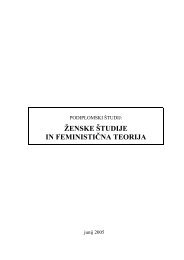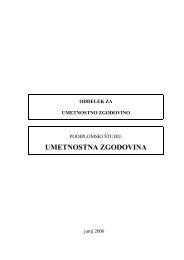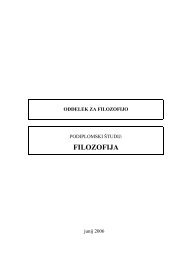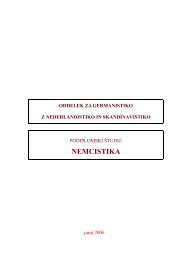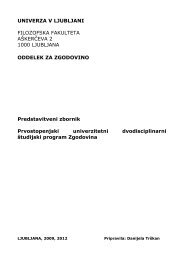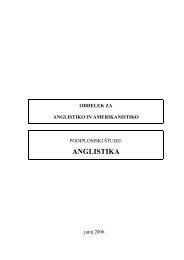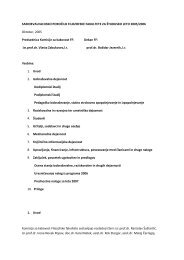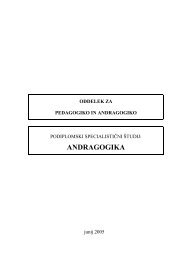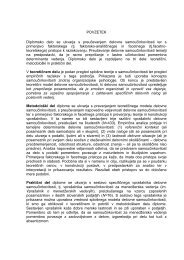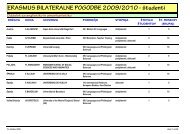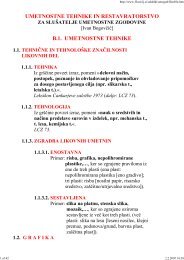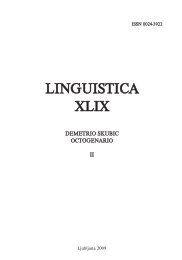B_solo_zgibanke male new_1 - Filozofska fakulteta
B_solo_zgibanke male new_1 - Filozofska fakulteta
B_solo_zgibanke male new_1 - Filozofska fakulteta
You also want an ePaper? Increase the reach of your titles
YUMPU automatically turns print PDFs into web optimized ePapers that Google loves.
easonable not only because of the numerous anatolian-Balto/Slavic isoglosses<br />
recognized today, but also because of Beekes’ theory about the primacy of the<br />
hysterodynamic 4 aP nom.sg. *CéC-r, acc. *CC-ér-¯, gen. *CC-r-ós (Beekes 1972,<br />
1985), which originates from Szemerényi (1960: 162 ff.). Specifically, it is possible<br />
that accusatives of the type iš-$i-me-na-an / ãkmenį / kamenь preserve the Pie archaic<br />
feature, although it is a Pie paradigmatic innovation.<br />
2. aNatOLiaN MateRiaL<br />
2.1. Hittite iš-$i-ma-a-aš : iš-$i-me-na-an ‘cord, rope’<br />
although Hitt. nom.sg.c. iš-i-ma-a-aš is oxytone, it should not be derived from<br />
*sH2i-m&(n)-s, as Oettinger (1980: 47) proposed, because the development of the Pie<br />
phonemic cluster *-&ns into Hitt. -āš is far from convincing. the assimilation *-éns ><br />
Hitt. -aš is well attested in gen.sg. -1aš < *-1én-s of verbal nouns in -1ar < *-1R, but the<br />
development of the long vowel *ē before *-ns or before preexisting Hitt. -s into a has<br />
not yet been proved. 5 in OH recorded nom.pl.c. iš$imāneš has a sequence -mān-<br />
< *-mon-, which clearly indicates that the noun could originate from the Pie<br />
holokinetic aP, 6 as assumed by Melchert (1983: 10). 7 therefore the Hitt. oxytonesis<br />
of the nominative singular must be of secondary origin.<br />
the root in iš$iman-/iš$imen- (c.) ‘cord, rope’ is the same as in the verb<br />
iš$ai-/iš$iº- ‘to bind, to tie’ and reflects the Pie verbal stem *sH2eº- ‘to bind, to tie’;<br />
cf. Oind. syáti ‘idem.’, Lith. siẽti, siejù. the Hittite noun is a Pie nomen actionis in<br />
*-men- with grammatical development into a nomen rei acti: *sH2eº- ‘to bind, to tie’<br />
→ *sH2eº-men- *‘binding’ > ‘cord, rope’. therefore, the zero-grade stem iš$i- in<br />
iš$iman-/iš$imen < *sH2i-men- is (as in Gr. λιμήν vs. λειμών or in Oind. tmánas vs.<br />
ātm%) not word-formationally but morphologically conditioned. the Hittite<br />
declension of iš$iman-/iš$imen- therefore only reflects the Pie original declension<br />
with the full-grade root. Such an opinion is based on the consistent single writing<br />
of intervocalic nasal m, which in addition to the zero-grade root indicates that the<br />
stem iš$iman-/iš$imen- must be the result of contamination between the Pie stem<br />
*sH2éº-mn- > Hitt. *iš$emn- and *sH2i-mén-> Hitt. *iš$immen-. the consistent single<br />
writing of the nasal fits the rule -ÓrV- = Hitt. -VrV- and not -VrÓ- = Hitt. -VrrV-. 8<br />
this indicates that this stem characteristic originates from Pie forms with the<br />
accent on the root and not on the suffix.<br />
4 Following Hoffmann’s terminology (eichner 1973: 91 n. 33), this paradigm is holokinetic.<br />
5 Otherwise, Melchert (1983: 9 n. 23).<br />
6 Hitt. $a-a-ra-aš (nom.sg.c.) < *H3érō + s also originates from the same type of aP.<br />
7 accepted by Rasmussen (1989: 38) and Rieken (1999: 41).<br />
8 For example, gēnu- (n.) ‘knee’ < *g’énu-; cf. Oind. jnu (nom.-acc.sg.n.) ‘idem.’; dāru- (n.) ‘tree,<br />
wood’ < *dóru (nom.-acc.sg.n.) = Oind. dru = Gr. δόρυ; kinu- ‘to open (up), to break open’<br />
< *g’híH 1 -ne1-); cf. CS. zinèti, zineši ‘to gape’, Lat. hīscō, -ere; gimaniºa- ‘to winter’ < *g’héºmon-ºe/o,<br />
but gimmant- (c.) ‘winter’ < *g’heºmén-t-; cf. Oind. hemantá- (m.) ‘idem.’; kuinna- ‘wife’<br />
< *g 1 enéH 2 = PSlav. *žen ’woman, wife’; lammar (adv.) ‘instantly, immediately’ < loc.sg. *nomér;<br />
cf. root-related OLat. numero (adv.) ‘idem.’<br />
294



